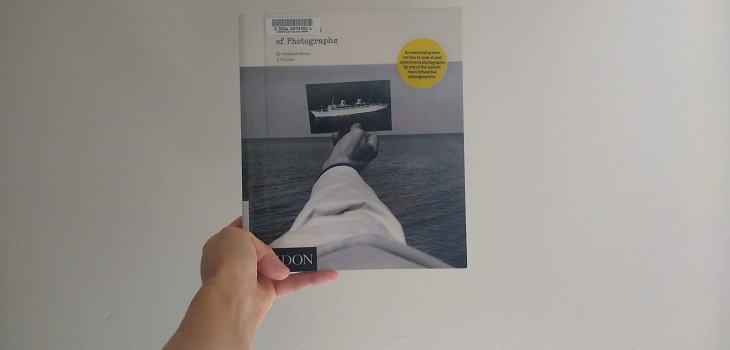 Book Review
Book Review
‘The Nature of Photographs’ Is as Rich as Prose-Poetry
A BOOK REVIEW OF STEPHEN SHORE’S NONFICTION PHOTOGRAPHY PRIMER
In this era of unlimited image feeds, selfies, and pictures appropriated for tawdry catch-phrases (memes, gifs, etc.), rarely do non-photographers pause to consider the basic elements that unite to compose a photo. We’re all bleary-eyed from bad pictures. Indeed, while many of us ordinary picture-takers can recognize when we take a nice photo, perhaps of a shadow resting in a clavicle, we can’t pinpoint why that particular image turned out to be so effective, and why the picture that we took of our foot turned out to be just an unattractive photo of our foot. To rein in chance and increase the probability of taking good pictures, we need to understand the nature of photographs — to see how what they’re made of affects how we experience them. And that’s what the nonfiction text, The Nature of Photographs: A Primer by Stephen Shore offers the rookie image-taker: an introduction to the intrinsic ingredients of photographs and how to identify these features when contemplating pictures.
THE NATURE OF PHOTOGRAPHS — BACKGROUND

I found Shore’s The Nature of Photographs: A Primer on the “Recently Returned” cart at the community college library where I work. It was a surprising discovery, since the students tend to ignore the thousands of thought-provoking books in the library stacks and stick to their predictable class textbooks. Then again, The Nature of Photographs is in the textbook family, in that it offers focused instruction on a particular area of study: photography. The subtitle labels it “A Primer,” and a yellow sticker on the cover clarifies that it’s “An essential primer on how to look at and understand photographs by one of the world’s most influential photographers.”
And that is indeed what this text by influential photographer Stephen Shore does: it initiates the reader-interested-in-photography-but-who-is-not-very-knowledgeable-about-all-the-details into the aesthetic elements of photographs. The author, Stephen Shore, directs Bard College’s photography program, and was one of the first photographers to work almost exclusively in color; his name is synonymous with photographic innovations. From ratings of this book online, it seems to be a favorite for college Intro to Photography courses, indicating that it’s a key first step for learning about pictures.
The Nature of Photographs is a quick read — 2 hours max — primarily because it’s filled with photos, as it should be. Published in 2007 by Phaidon, which is synonymous with glossy, meticulously fashioned, smart coffee table texts, Shore’s book is similarly conscious of its own design — again, as it should be, since the text delves into the implications of how photographs look and how the reader looks at The Nature of Photographs as a book. As such, we’ll briefly delve into its appearance too.
THE NATURE OF PHOTOGRAPHS — DESIGN AND ORGANIZATION
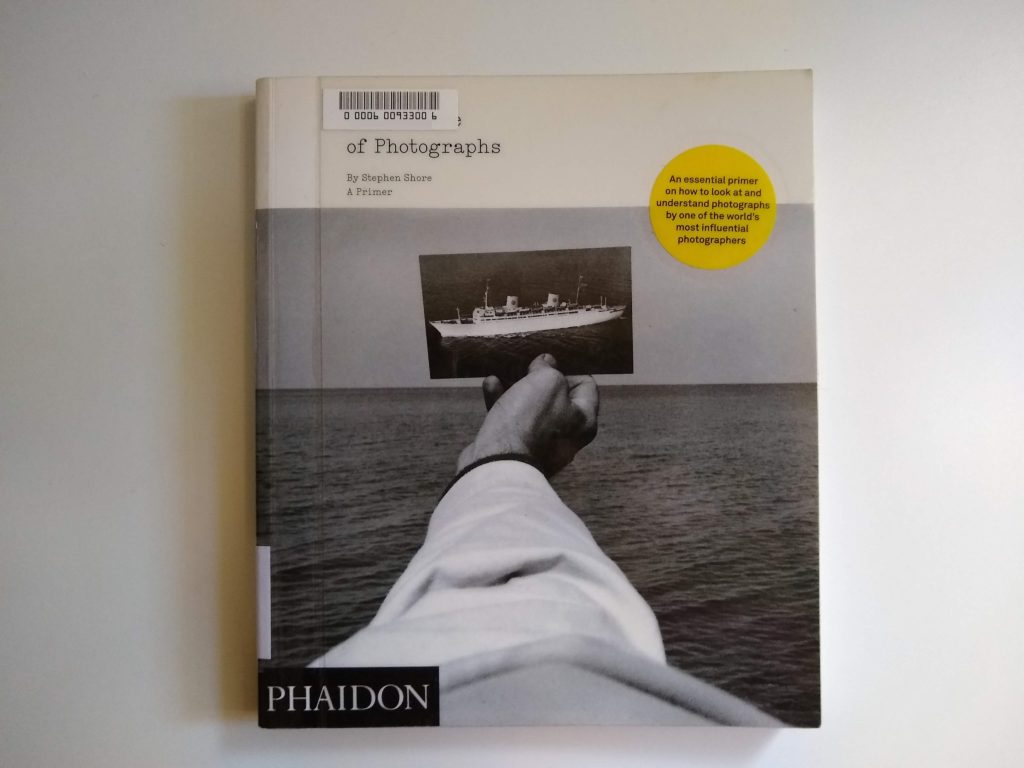
As you can see from my photo, the front cover features a black and white photo of an outstretched white-coat-clad arm holding a photo of a cruise ship apparently above the horizon of the endless ocean. If we pause and consider that you’re looking at a digital copy of my photo of a reproduction of another photo containing another photo, our brains might burst, so let’s stick to the primary image: it’s a picture about a picture, and thus, a photo that’s aware of itself as a snapped image. This meta-photograph is a good choice for the cover because it foretells a text that will analyze photographs and the information they provide.
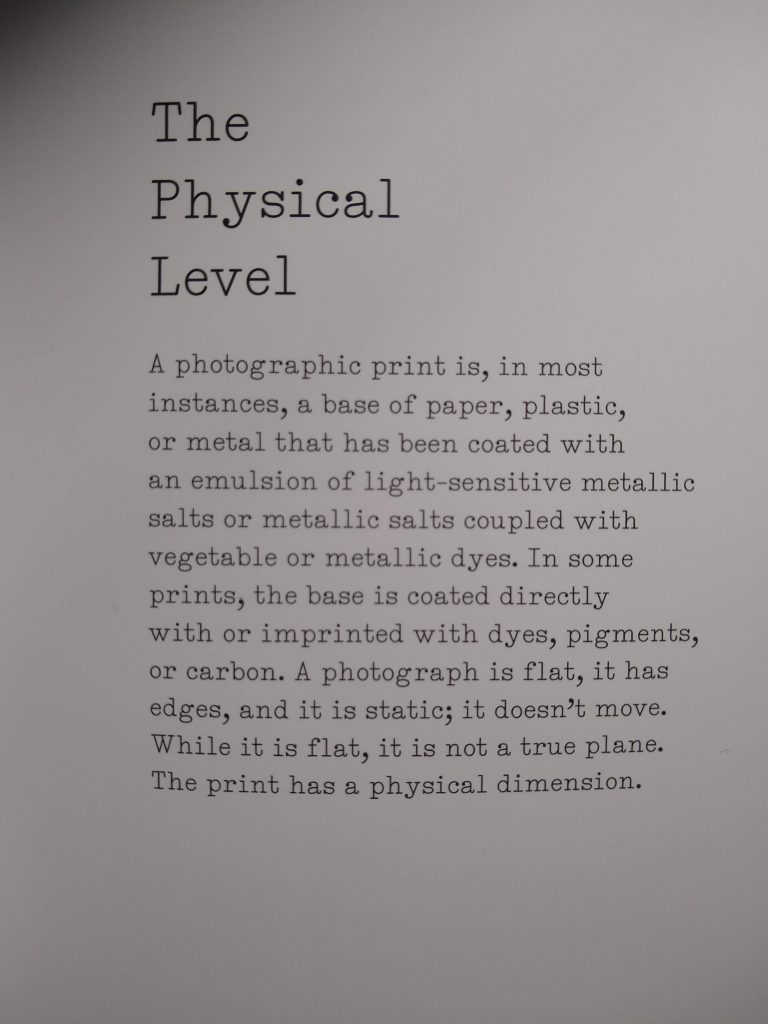
The typeface, designed by “A2/SW/HK,” is reminiscent of Courier — that ubiquitous, looks-like-a-typewriter-but-was-actually-written-on-a-Macbook font that usually reeks of faux literature. However, it appears here darker-hued, globular tipped, and condensed space-wise, making it both attractive and evocative of black and white photographs. The latter analogy is particularly palpable, since the textual units/paragraphs are un-indented rectangles. These textual blocks are as concise and fecund as photographs — succinct blocks of ink that are as efficient and rich as prose poems in their visual analysis.
The “Contents” let’s us know that the book is divided into five primary sections:
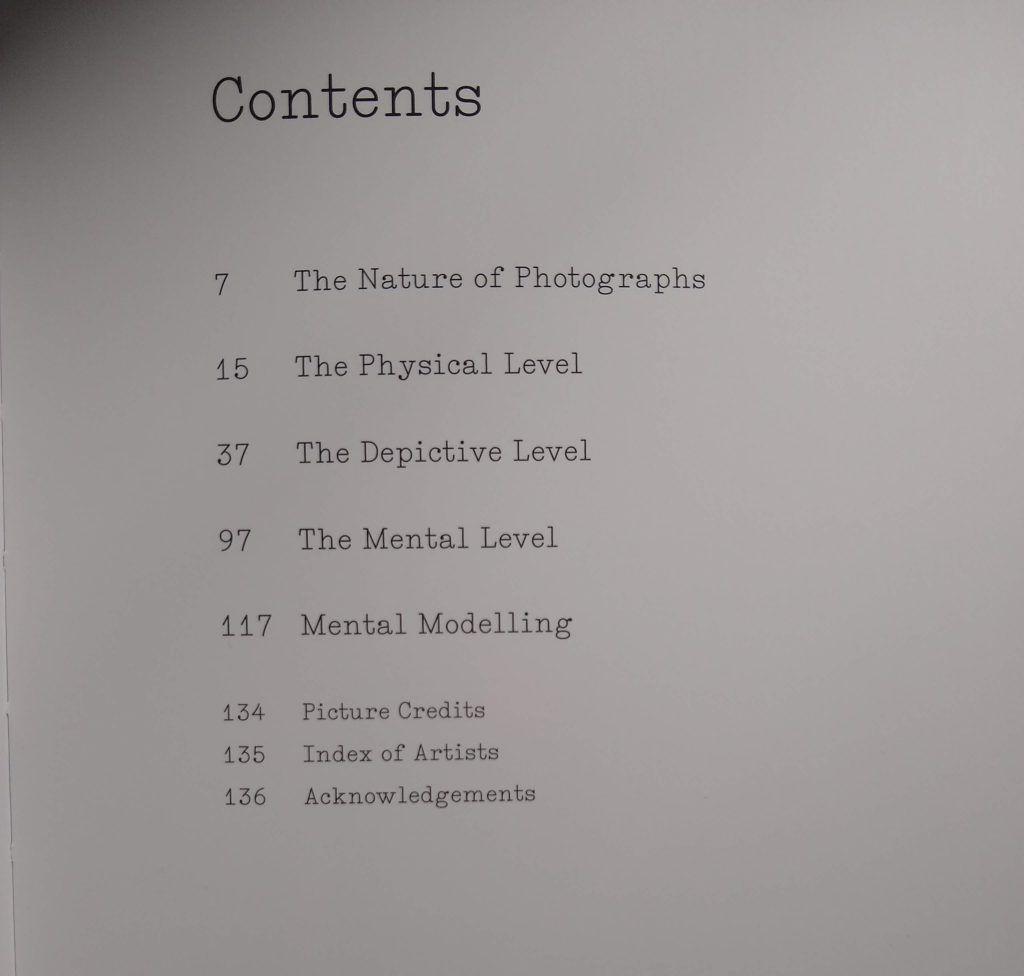
Design-wise, this organization turns out to be somewhat indistinct, since each chapter is bookended by photographs and the sections seem to run into each other. This is complicated by the fact that “The Nature of Photographs” isn’t so much a chapter as a preface, and “Mental Modelling” isn’t so much a chapter as an epilogue. Also, “The Depictive Level” contains sub-sections, such as “Time” and “Focus,” as indicated by footers within the chapter, but only indicated by those footers — there are no primary textual indications of structural sub-transitions. I draw attention to these design nitpicks because they impact the text’s effectiveness, particularly when the text draws attention to itself as designed.
Because The Nature of Photographs is undeniably meta. For example, Shore informs the reader that:
You see a mental image — a mental construction — when you read this page, or look at a photograph, or see anything else in the world. Your focus even shifts when reading this picture by Paul Caponigro. But your eyes don’t actually refocus (since you are only looking at a flat page)…”
pp. 97
Here, the author is directly inviting the reader to consider his book as a read object. Now if we pause to think about that quote extracted and transcribed by me digitally from a mass reproduced text transcribed from Shore’s original manuscript, and the fact that the original meaning remains intact, our minds really will rupture, so let’s move on.
THE NATURE OF PHOTOGRAPHS — CONTENT
Despite the hazy organization, The Nature of Photographs: A Primer proves itself to be an excellent photography primer, striking a balance between philosophy and technique. My prior literary interactions with photography consist of Susan Sontag’s On Photography, which primarily looks at how photos influence our perspective and world-experience, and Errol Morris’s Believing is Seeing, which examines the veracity of photographic images and their nexus with history. In contrast, The Nature of Photographs is more ingredient-focused: Shore teaches the reader how to look at all the parts of pictures like a photographer in order that we may recognize potential photographs in real life and become photographers ourselves.
CHAPTER 1: “THE NATURE OF PHOTOGRAPHS”
This educational intent is made clear in the book’s thesis stated in “The Nature of Photographs” chapter/preface:
The aim of this book then is not to explore photographic content, but to describe physical and formal attributes of a photographic print that form the tools a photographer uses to define and interpret that content.”
pp.12
From this, I expect that Shore will provide me with tools to look at a photograph and analyze it as a professional would — much in the same way that I, as a professional poet, feel confident looking at a poem and noting the dynamic meanings created by enjambment, meter, slant rhyme, etc., and in turn employing such tools in my own writing. As the classic proverb says: “As good readers become great writers, good lookers become great photographers.”
CHAPTER 2: “THE PHYSICAL LEVEL”
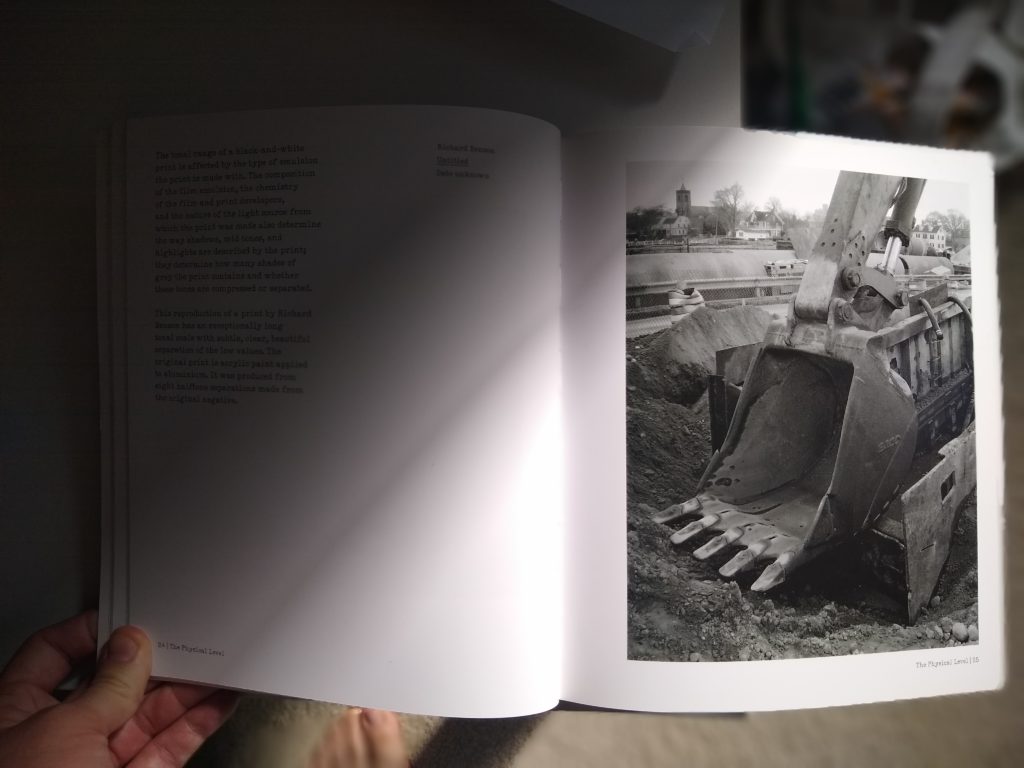
The first real handling of these tools in The Nature of Photographs is in “The Physical Level.” Here we’re literally talking about the literal photograph: the material and planar attributes of the image, and how variables such as “the edges of the print demand the boundedness of the picture” (16). Shore presents the photograph to us as an object and ensures that we see it as that, and not simply a depiction. He supports his assertions with a variety of photographs, from pieces by Anonymous to one by Walker Evans, along with three of his own works. The result is a curated range from fair-to-middling photos to exceptional ones, which all manifest the physical level properties he’s describing, thus proving Shore’s thesis in this chapter; every photographic print is defined by the relationship between its physical characteristics.
Shore’s writing style is pithy, philosophical, and poetic. Each sentence is plump with information, and feels like it could stand on its own if it were extracted from the text. In other words, each sentence feels like a thesis statement — a feat that is quite hard to maintain across an entire book. For example, in this chapter alone, we learn that “Colour expands a photograph’s palette and adds a new level of descriptive information and transparency to the image” (18), and “The context in which a photograph is seen effects the meanings a viewer draws from it” (26), and “By consciously adopting a visual style, a photographer can reference this context and bring these meanings into the reading of the image…” (34), to quote a few lines. Shore is brilliant at distilling complex concepts into tight, lucid sentences.
CHAPTER 3: “THE DEPICTIVE LEVEL”
The next chapter is when we start digging into photo as depictions. In “The Depictive Level,” Shore fleshes out “the four central ways in which the world in front of the camera is transformed into the photograph: flatness, frame, time, and focus” (38). What an image shows depends on how it’s shown, and that “how” is determined by those four elements. This is a chapter lush with insight. In it, I learned how to “see” the flatness of a photo and its illusions of “deep space” (40), how to understand how a photo frames a subject and “energizes the space around the figures” (58), how a “photographic meaning, is delineated” (70) in the flow of time when a photo (a static object) is taken, and how a photo “creates a hierarchy in the depictive space by defining a single plane of focus” which “gives emphasis to part of the picture” (83).
In most cases, each mode of interpretation presented by Shore is immediately applicable to the accompanying photographs; for example, when we look at his color photo “El Paso Street,” we can recognize how the “frame” encloses the image and narrows the world to a tree, a man, and a few buildings in El Paso Texas. Although this is a primer, Shore tends to introduce concepts couched in technical terminology — and in order to understand them, the reader must take time to study the pictures that function as visual reinforcements to the textual assertions.
CHAPTER 4: “THE MENTAL LEVEL”
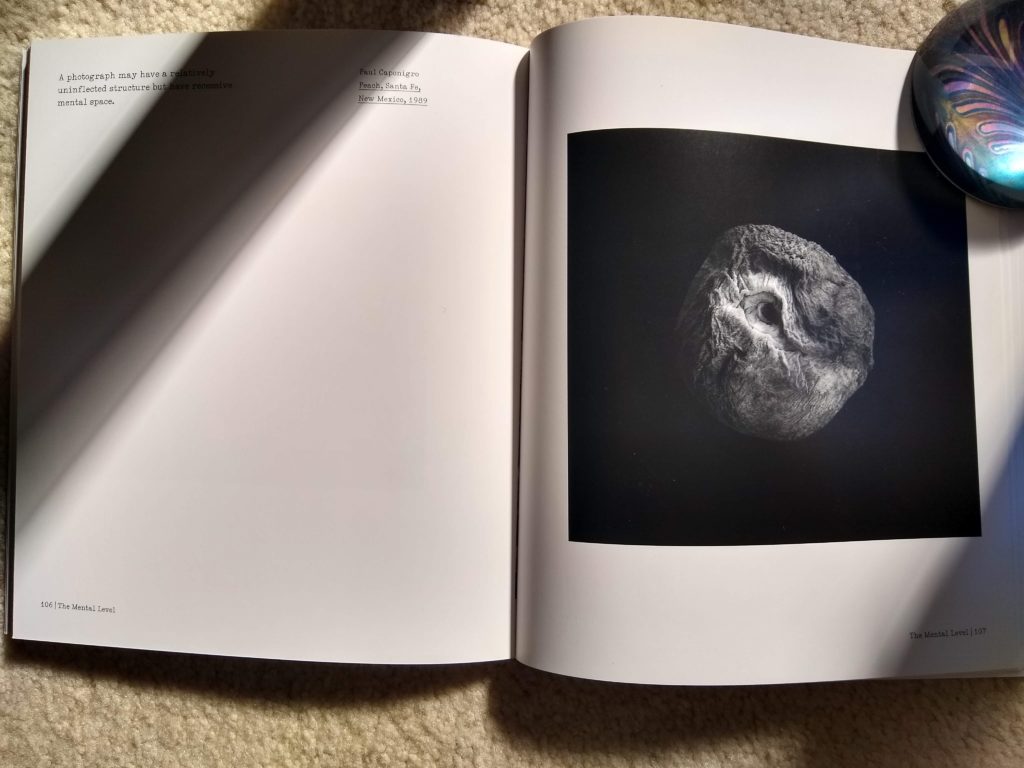
In a few instances though, the language was too technical to decipher via the dictionary of the adjacent photograph. For example, in the subsequent chapter, “The Mental Level,” the cryptic assertion that, “A photograph may have a relatively uninflected structure but have recessive mental space” is the only text that accompanies Paul Caponigro’s haunting photo of a shriveled “Peach” (106). When I study Caponigro’s black and white photo of a fruit that has taken on the appearance of a reptilian egg or eye or both, I can’t quite glean what Shore means. I love the photo, but I don’t feel more knowledgeable about it based on the accompanying words. Ultimately, Shore’s descriptions are most successful when he takes my hand — I mean my eyeball — and drags it across the photo, calling attention to each point of focus as we go.
As a whole, “The Mental Level” chapter concentrates on the cerebral experience of looking at a photograph, which is distinct from, but influenced by the aforementioned formal depictive elements. With its instances of direct dialogue with the reader, this is an intriguing chapter that makes you feel like you’re looking at your own brain or the back of your eyeballs…I’ll wait while you try that for a second.
CHAPTER 5: “MENTAL MODELLING”
The final chapter, “Mental Modelling,” synthesizes everything we just learned about looking at pictures into a poetic explanation of the actual act of taking a photograph. Here, we’re granted access into the photographer’s mind, and how each photographer’s “mental model” or “mental organization” determines, in part, what image will be produced. This mental model is constantly being updated through daily experiences, learning, and conscious shifts of attention. For example, Shore reminds us that:
Earlier I suggested that you become aware of the space between you and the page in this book. That caused an alteration of your mental model. You can add to this awareness by being mindful, right now, of yourself sitting in your chair, its back pressing against your spine. To this you can add an awareness of the sounds in your room. And all the while, as your awareness is shifting and your mental model is metamorphosing, you are reading this book…”
pp. 117
This directive immediately felt familiar to me because this is my basic compositional process for a poem: a fluid shifting of my attention to all of the elements that compose the habitual, to rediscover my surroundings, my existence, and my consciousness.
THE NATURE OF PHOTOGRAPHS BOOK REVIEW — FINAL WORD
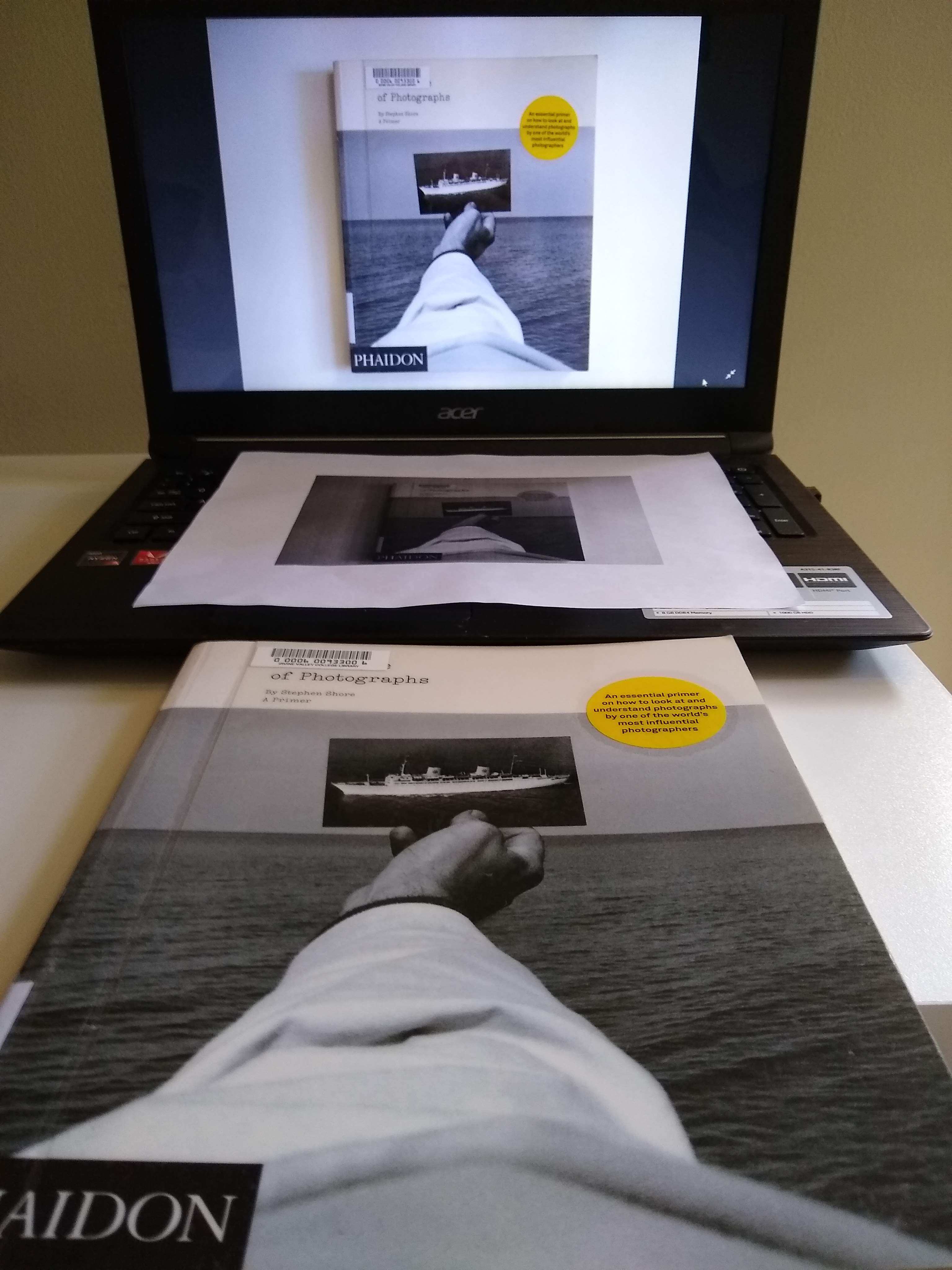
Despite some minor quibbles, I quite liked The Nature of Photographs. The organizational design of the chapters could be more distinct to facilitate a greater clarity of subject. Further, the text is sometimes so concise as to be cryptic for a sapling reader-photographer like me who doesn’t have much photographic vocabulary. More often though, the jargon works because the corresponding pictures illuminate and expand upon the text’s meaning. Overall, the pictures throughout this book are striking and worthy of long attention, regardless of photographer. Shore reveals that even the most innocuous image can serve as a fruitful learning experience in physical and formal photographic attributes. Because the book contains images that I would want to return to to contemplate, and text is something that I would want to re-read, I could see buying this book and leaving it on my coffee table (once I also buy a coffee table). Overall, The Nature of Photographs: A Primer by Stephen Shore is filled with quotable assertions about photography; I’d categorize it as a textbook of photographic aphorisms. Finally, it is a book that’s incredibly effective at guiding the reader across images to reveal nuances we could never label before, and after finishing it, I have a clearer picture of pictures.
ISBN of Edition Read: 9780714859040
Notes of Oak Literary Blog Book Review Score for: The Nature of Photographs: A Primer by Stephen Shore
7/10


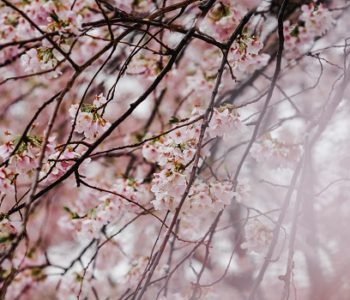
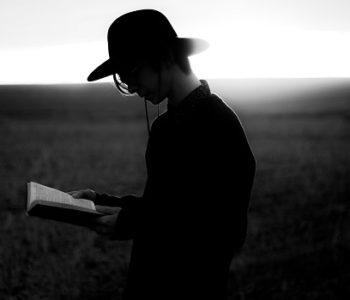
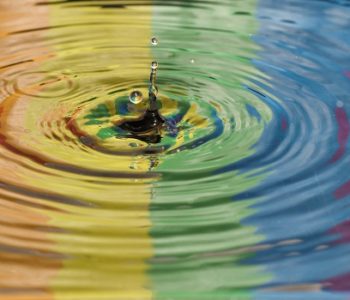



1 COMMENT
As a retired architect and an amateur photographer, I found the review of “The Nature Of Photographs: A Primer” by Hannah Huff very helpful, excellent.